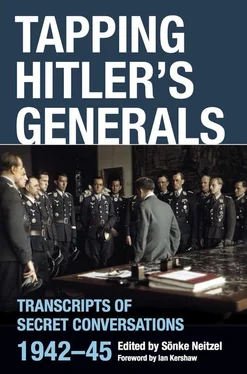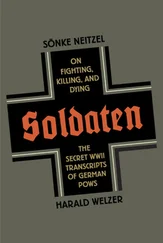On 5 October 1940 it was decided to increase CSDIC (UK) staffing levels to enable two camps to be run simultaneously. Trent Park could house only a limited number of prisoners and space for the constantly growing number of assessors was inadequate. It was also considered prudent to have two centres in order to reduce the risk of losing everything in a Luftwaffe air raid.
On 15 July 1942 CSDIC (UK) moved with its entire staff into the new interrogation centre at Latimer House at Chesham, Buckinghamshire (No. 1 Distribution Centre) with a maximum capacity of 204 prisoners. On 13 December a second new centre ten miles away at Wilton Park, Beaconsfield (No. 2 Distribution Centre) was opened with room for 142 prisoners, mainly Italians. [21] Between 15.7.1942 and the opening of Beaconsfield on 13.12.1942, the interrogation and recording of Italian prisoners was undertaken at Newmarket using a mobile unit near the Italian PoW camp.
The opening of the two new institutions allowed Trent Park to be converted into a long-term centre for German Staff officers. In the relaxed atmosphere it was hoped that its high-ranking population would reveal secrets in their private discussions. [22] The usual stay in standard interrogation centres was a few days to several weeks. As soon as it was thought there was nothing more to be gained from him, a prisoner would be shipped out, before 1944, to either Canada or the Near East. Numbers to the end of 1943 were between 300 and 1,850 men, after Normandy this increased rapidly to 144,450 by the end of that year. Wolff, ‘ Die deutschen, Kriegsgefangenen in britischer Hand ’, p. 20f.
The first new prisoner was General Ludwig Crüwell. He had been captured in North Africa on 29 May 1942 and arrived at Trent Park on 26 August after a long sea voyage. He was joined on 20 November 1942 by General Wilhelm Ritter von Thoma, a prisoner of the British for the previous two weeks.
For the sake of variation and to initiate fresh themes in conversation, from time to time selected prisoners were transferred to Trent Park. These included Kapitänleutnant Hans-Dietrich Tiesenhausen [23] Kapitänleutnant Hans-Dietrich Freiherr von Tiesenhausen (22.2.1913–17.8.2000) was taken prisoner on 17.11.1942 when his U-boat was sunk. He arrived at Trent Park on 20.1.1943.
and Major Burckhardt, von Thoma’s former adjutant during the Spanish Civil War. They remained only a few weeks before being shipped out to Canada. [24] The following prisoners were with Crüwell at Trent Park for at least a few weeks from August 1942: Lt Schumann (Army), captured North Africa, 27.5.1942; Oberleutnant Faber, Fw190 pilot shot down 23.6.1942; Oberleutnant Guntram von Waldeck alias Krause, allegedly an Fw190 pilot claiming to have been shot down 2.9.1942, probably an informer; from 31.10.1942 Oberleutnant zur See Römer, commander U-353, sunk North Atlantic, 16.10.1942. The first German general captured by the British, Generalleutnant Johann von Ravenstein, was never at Trent Park.
Following the capitulation of Army-Group Afrika in May 1943, 18 senior officers ranging from the rank of Oberst to Generaloberst came to Trent Park. From the end of June 1944 there followed permanent prisoners picked up by the Allies during their push through France, Belgium and into Germany, [25] A list of Trent Park prisoners exists only for the period from spring 1945 onwards.
and by April 1945 the number of generals at Trent Park exceeded the capacity. The overflow went to other camps including Latimer House and Grizedale Hall at Hawkshead, Lancashire (No. 1 Camp). From August 1942 to its closure on 19 October 1945, 84 German generals made stays at Trent Park. To these must be added at least 22 officers of the rank of Oberst and an unknown number of other ranks, mostly adjutants and valets. [26] No complete list of the prisoners held at Trent Park is available; the names of generals have been adduced from various sources.
The total number of generals held until October 1945 temporarily in British interrogation centres was 302 of whom 82 per cent (248) arrived in England after April 1945.
After the Normandy landings in 1944, interrogation camps at Kempton Park (Sunbury-on-Thames, Middlesex: British Army) and Devizes, Wiltshire (US Army) were opened to receive German prisoners captured in France, while at Kensington the ‘London District Cage’ was set up for prisoners suspected by the British to be implicated in, or to have guilty knowledge of, war crimes. [27] Certain prisoners of 12.SS-Panzerdivision Hitler Jugend , believed to be implicated in the murder of Canadian prisoners in Normandy in June 1944, were interrogated and recorded at London District Cage. Some of these reports are at TNA WO 208/4295. See also Neitzel, ‘Des Forschens noch wert?’.
At the latter the incumbents were subjected to psychological torture. [28] Sullivan, ‘Auf der Schwelle zum Frieden’.
Following the German capitulation the work of CSDIC (UK) turned to obtaining information on German war crimes. On 19 November 1945 the interrogation centre in England was closed, its work being transferred gradually since summer 1945 to the new CSDIC in Germany. [29] ‘Future Policy Regarding Interrogation Centres, Joint Intelligence Sub-Committee’, Meeting, Tuesday 28 August 1945: TNA WO 208/3451.
A month before, when Trent Park closed its doors, the remaining prisoners were sent to other camps and no longer monitored. [30] A large number of generals arrived later at Island Farm Special Camp 11 at Bridgehead, South Wales opened on 6.1.1946. See website at www.islandfarm.fsnet.co.uk .
In general, all German prisoners of senior rank were brought to England for interrogation irrespective of which Allied forces had captured them. A few were shipped to the United States after brief questioning, so that many Trent Park generals did not spend the whole war in England. 31 went in several batches to the enemy generals’ camp at Clinton, Mississippi, providing the United States in the spring of 1945 with the opportunity to obtain information from an approximately equal-sized number of senior German military officers as the British had. [31] For German generals in American captivity see Krammer, ‘American Treatment of German Generals’.
There does not seem to have been any special guidelines for selection for transfer to the USA: almost all ranks and political standpoints were represented. The British clearly liked a broad sweep of characters and opinions in their camps to keep the conversations flowing.
The expense incurred in maintaining the three eavesdropping units at Trent Park, Latimer House and Wilton Park was enormous: at the beginning of 1943, 994 persons staffed the units and evaluated the monitored conversations, 258 of these being from the intelligence services. [32] Until 1945 the number of personnel at the three centres remained constant. In March 1945 CSDIC (UK) employed 967 staff, 218 of these being engaged on intelligence work, 192 were guards and 28 worked on technical maintenance, War Establishment Committee Investigating Section, CSDIC (UK) 19.3.1945 TNA WO 208/3451.
From September 1939 to October 1945, 10,191 German and 567 Italian prisoners passed through these centres; between 1941 and 1945 64,427 conversations were recorded on gramophone discs. CSDIC prepared 16,960 protocols from German, and 18,903 from Italian prisoners, [33] At TNA WO 208/4136–40 there are protocols for 3,838 Kriegsmarine prisoners overheard (SRN 1–4857), 3,609 Luftwaffe prisoners (SRA 1–5836), 2,748 Army and Waffen-SS prisoners (SRM 1–1264) and 2,076 prisoners of several branches together (SRX 1–2141).
varying in length from half a page to 22 pages.
Читать дальше








![Traudl Junge - Hitler's Last Secretary - A Firsthand Account of Life with Hitler [aka Until the Final Hour]](/books/416681/traudl-junge-hitler-s-last-secretary-a-firsthand-thumb.webp)



